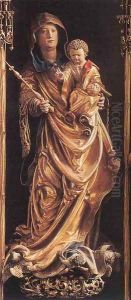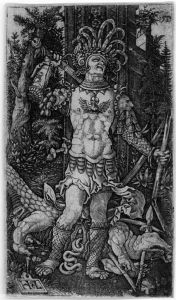Hans Leinberger Paintings
Hans Leinberger, a prominent name in the world of late Gothic art, was an artist whose life and works remain shrouded in mystery. Born around the 1480-1490 period, likely in the region that is today Southern Germany or Austria, Leinberger's exact birthplace and early life details are largely undocumented. Despite the scarcity of personal information, his artistic legacy, particularly from the early 16th century, highlights his significance in the Northern Renaissance's sculptural landscape. He is believed to have died around 1531, but like much of his life, the exact circumstances and location of his death remain elusive.
Leinberger's work primarily encompassed religious themes, reflecting the intense piety of the period. He was especially renowned for his wood sculptures, altarpieces, and smaller devotional pieces, which were noted for their intricate detail, emotional expressiveness, and technical mastery. His ability to imbue wooden figures with a sense of dynamic movement and profound spirituality was unmatched, making him a sought-after artist in his time. Additionally, Leinberger also worked with stone and bronze, showcasing a versatile talent in various mediums.
Although specific records of his patrons are limited, it is known that Leinberger's works were commissioned by both ecclesiastical and secular authorities, indicating his high reputation across different strata of society. His sculptures, characterized by their vivid realism and the delicate treatment of surfaces, were highly influential in the development of German sculpture during the transition from the Gothic to the Renaissance style. Notable works attributed to Leinberger include the Lamentation of Christ and the figure of Saint George slaying the dragon, pieces that exemplify his skill in conveying narrative through sculpture.
Despite his evident influence and the quality of his surviving works, Hans Leinberger remains a somewhat enigmatic figure in the history of art. The lack of comprehensive archival material has led to challenges in fully documenting his life and career. However, the beauty and craftsmanship of his sculptures continue to be admired, securing his place among the notable artists of the Northern Renaissance. His legacy is preserved in various museums and collections across Europe, where his works continue to be studied and appreciated for their contribution to the evolution of sculpture during a pivotal era in art history.

